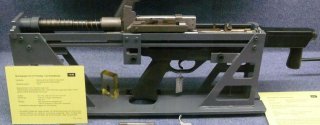G11: The Insane Looking Gun That Failed Miserably
On paper the G11 was revolutionary: it offered benefits in ammunition capacity, accuracy, and weight—but here’s why it wasn’t accepted into service.
On paper the G11 was revolutionary: it offered benefits in ammunition capacity, accuracy, and weight—but here’s why it wasn’t accepted into service.
The G11 was a multi-nation initiative that was ultimately pursued solely by West Germany and sought to equip soldiers with a lighter, higher-capacity, more compact, and much more accurate rifle. Though the rifle did indeed feature several novel features and met many of the requirements required of it, it was a flop.
The G11’s housing is immediately striking. Its matte boxy housing is a polymer intended to keep weight lower than a metallic housing. The fire selector has four positions, safe, semi-auto, three-round burst set at approximately two thousand rounds per minute, and full auto set to about six hundred rounds per minute. The idea behind the G11’s blisteringly high three-round burst was that the third round would leave the barrel before the shooter would perceive recoil, keeping the weapon on target during firing and hopefully putting more rounds more accurately downrange.
Atop the G11’s bulky receiver was a prominent carry handle that doubled as the rifle’s optic—that was a non-magnifying, 1x optic sight that merely offered the shooter a simple cross reticle, though some G11’s were outfitted with a 3.5x optic. The G11 lacked a charging handle: it opted for a rotating drum charger just rear of the trigger group that would chamber a caseless cartridge with one full revolution.
Cartridge
One of the biggest challenges that the G11 faced was its radical caseless ammunition which attempted to offer shorter and lighter cartridges compared to traditional ammunition. This was done by creating a rectangular plastic casing in which the bullet sat, surrounded by propellant: the final G11 iteration was chambered in small, 4.73x33 caseless ammunition.
Though the cartridges were indeed lighter and more compact, they were not necessarily as reliable as traditional brass cased ammunition and were rather brittle, prone to cracking or chipping if dropped. One way to protect the fragile cartridges was to issue clips of caseless ammunition held in packages somewhat akin to stripper clips with which to charge magazines. Though this did help to protect the ammunition, its glaring drawback was the time required to reload increased and an obvious disadvantage. Cook-off was also a problem. Metallic cases serve to help dissipate heat generated by firing a gun: the cases get hot, but then are quickly ejected. Polymer caseless ammunition could not absorb heat, which would then radiate throughout the receive and/or barrel.
Interestingly, the G11’s single-stack magazines are loaded horizontally above the action and can hold fifty rounds. The G11 could hold a total of three magazines, one loaded and two held in reserve on either side and parallel to the loaded magazine, giving the G11 150 rounds of readily accessible ammunition at a huge weight advantage. Below the magazines and barrel, the G11 had a space for clipping a laser optic to help with aiming.
Despite the G11’s obvious shortcomings, Hecker & Koch decided to enter the rifle into the Advanced Combat Rifle program, a U.S. Army initiative that sought to find a replacement for the M16 platform that could offer better accuracy than its predecessor. Ultimately however the rifle was unsuccessful in the United States. Along with an almost-unbelievably complicated action, the rifle’s ammunition had the aforementioned shortcomings.
Amazingly, West Germany approved the rifle for use by the German Bundeswehr in early 1990. However, the impetus for a new rifle disappeared with the reunification of East and Western Germany as well as the subsequent collapse of the Soviet Union. Along with lacking a clear enemy, the financial cost of uniting with the former East became apparent and was prioritized over a new radical rifle. Put together both factors doomed the G11 program to the history books.
Interestingly, the U.S. Army is currently pursuing a new rifle initiative that is also experimenting with caseless ammunition, though the same challenge concerning heat dissipation remains. Will it be a revolution in small arms—or a flop?
Caleb Larson is a Defense Writer with The National Interest. He holds a Master of Public Policy and covers U.S. and Russian security, European defense issues, and German politics and culture.
Image: Creative Commons.

